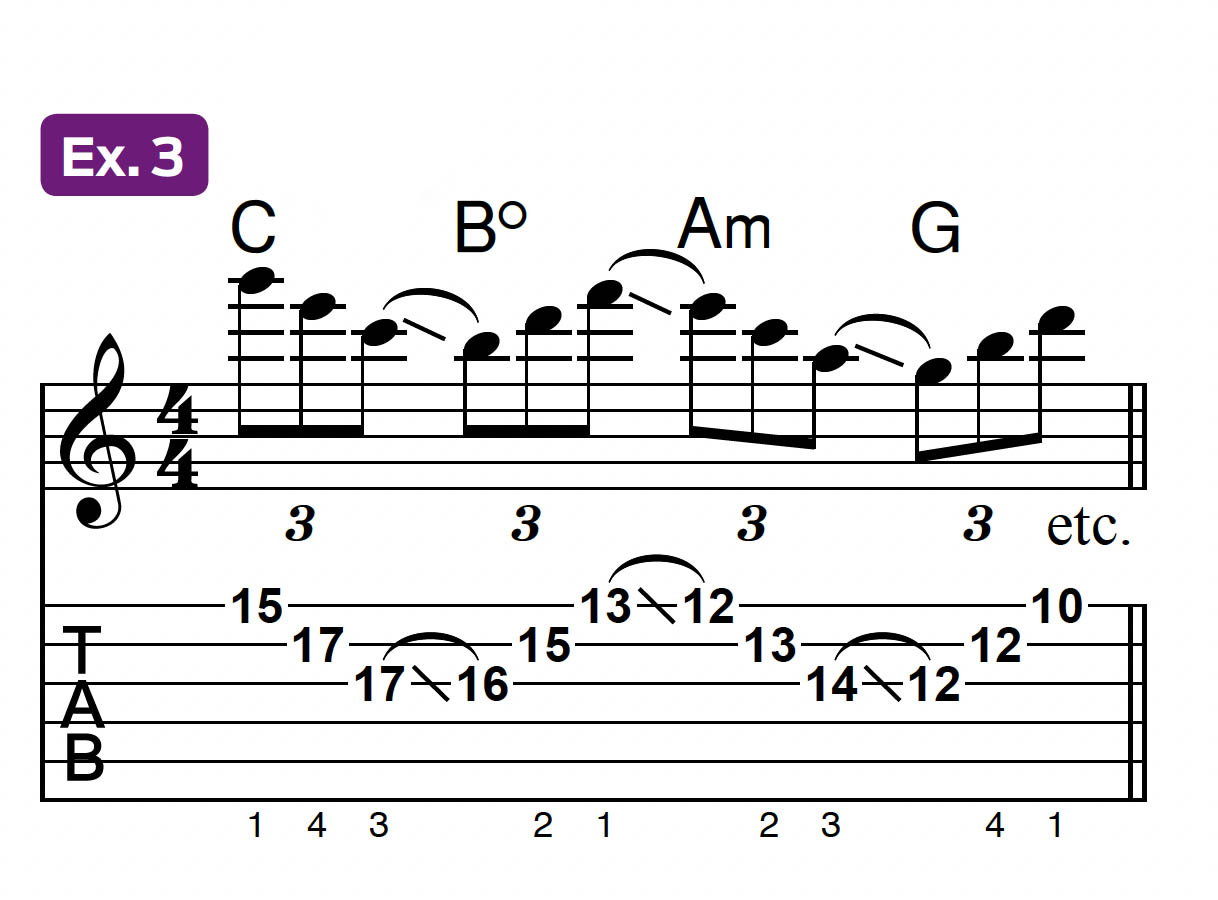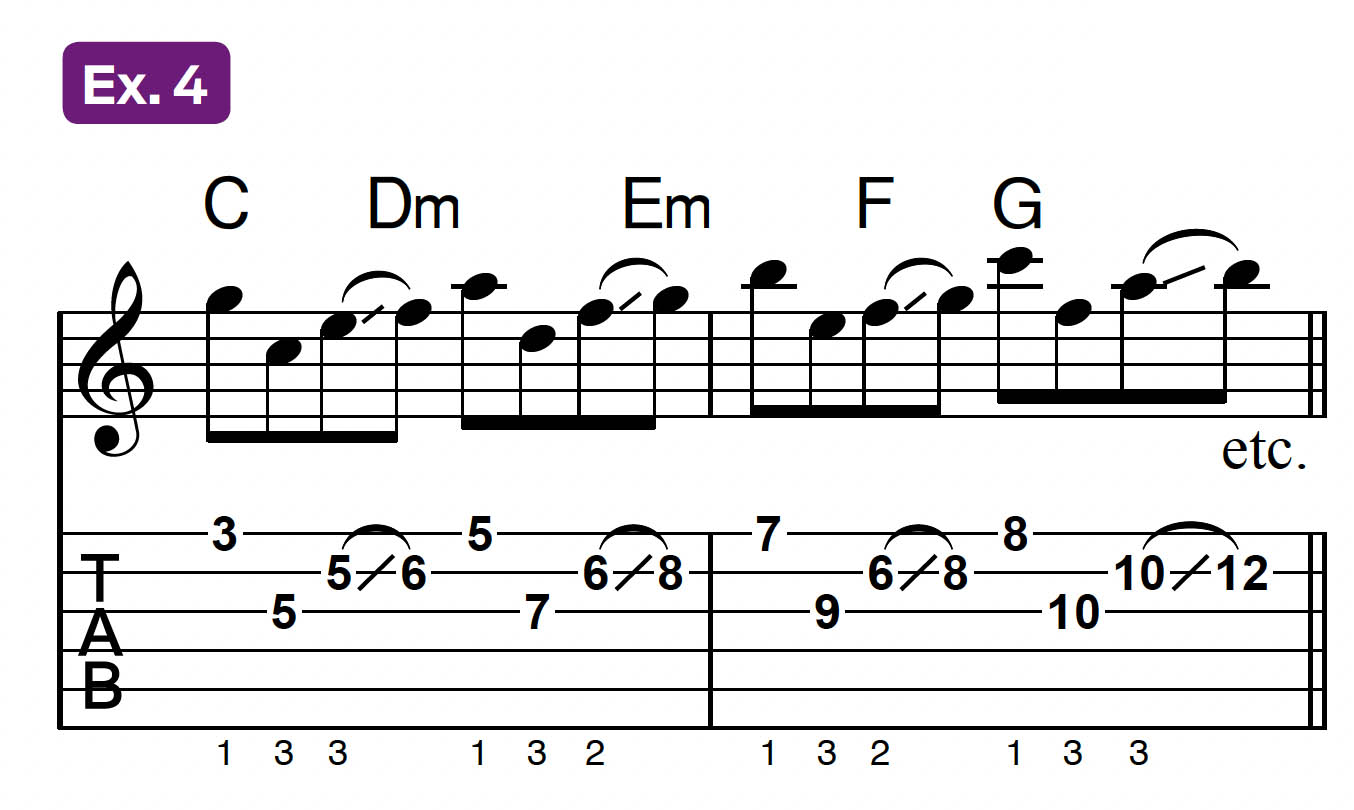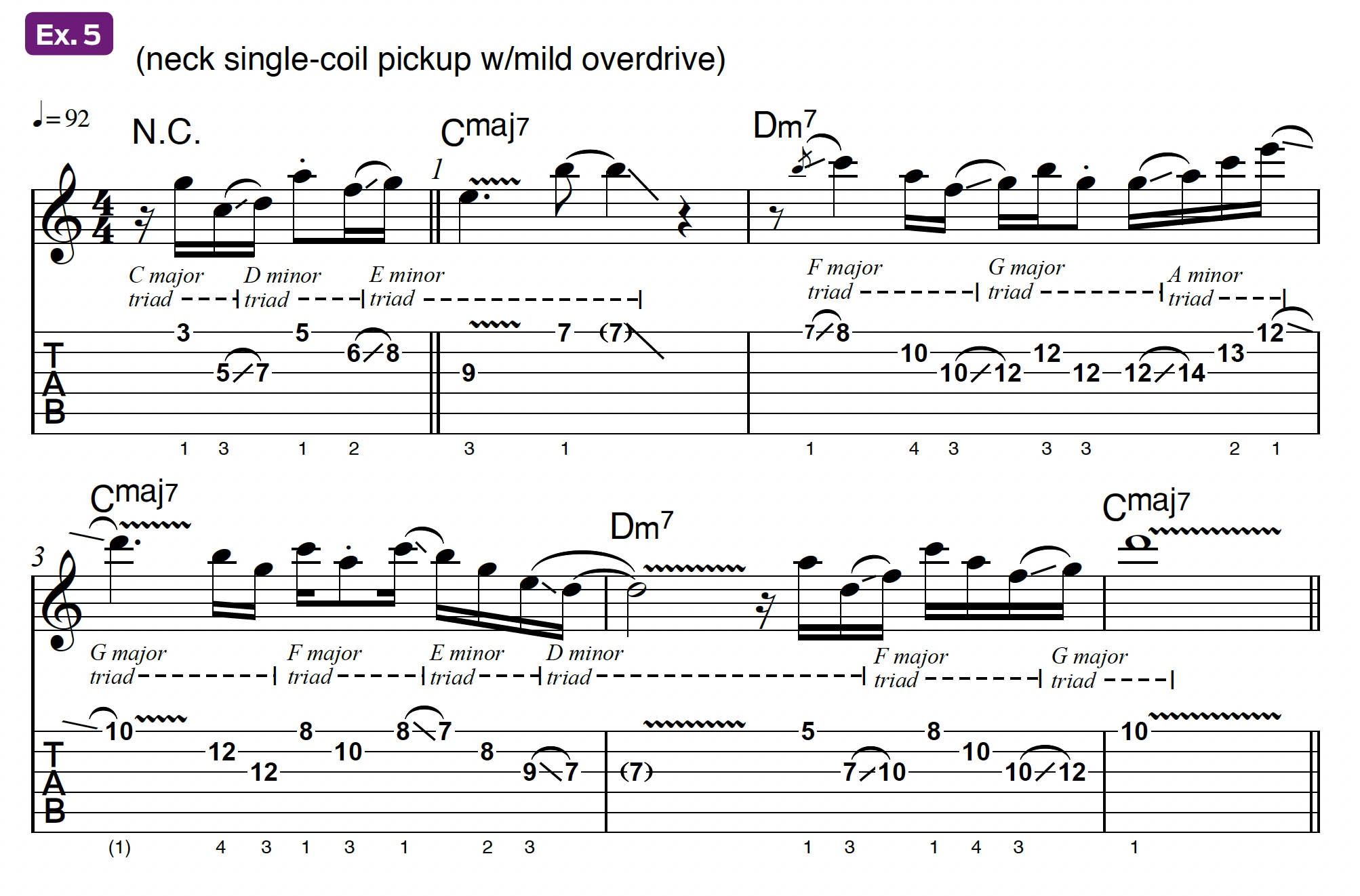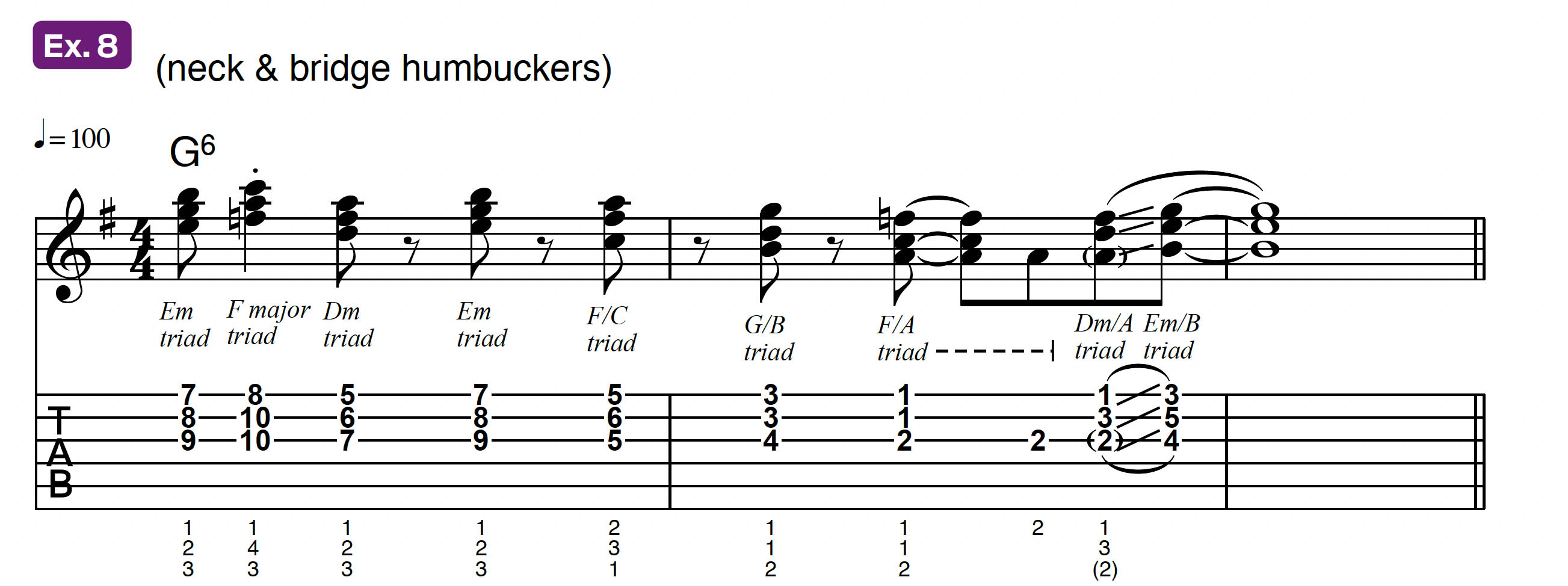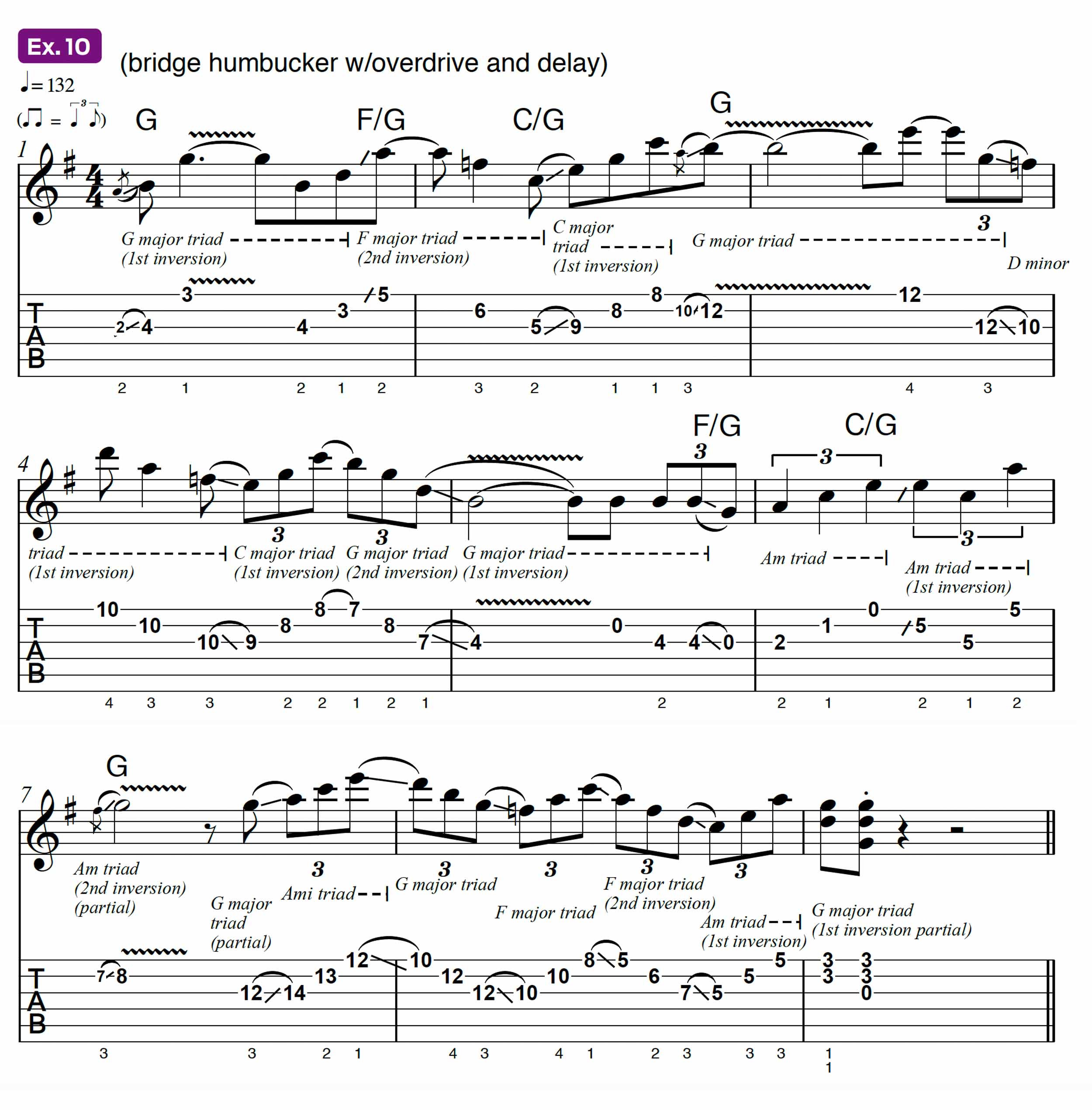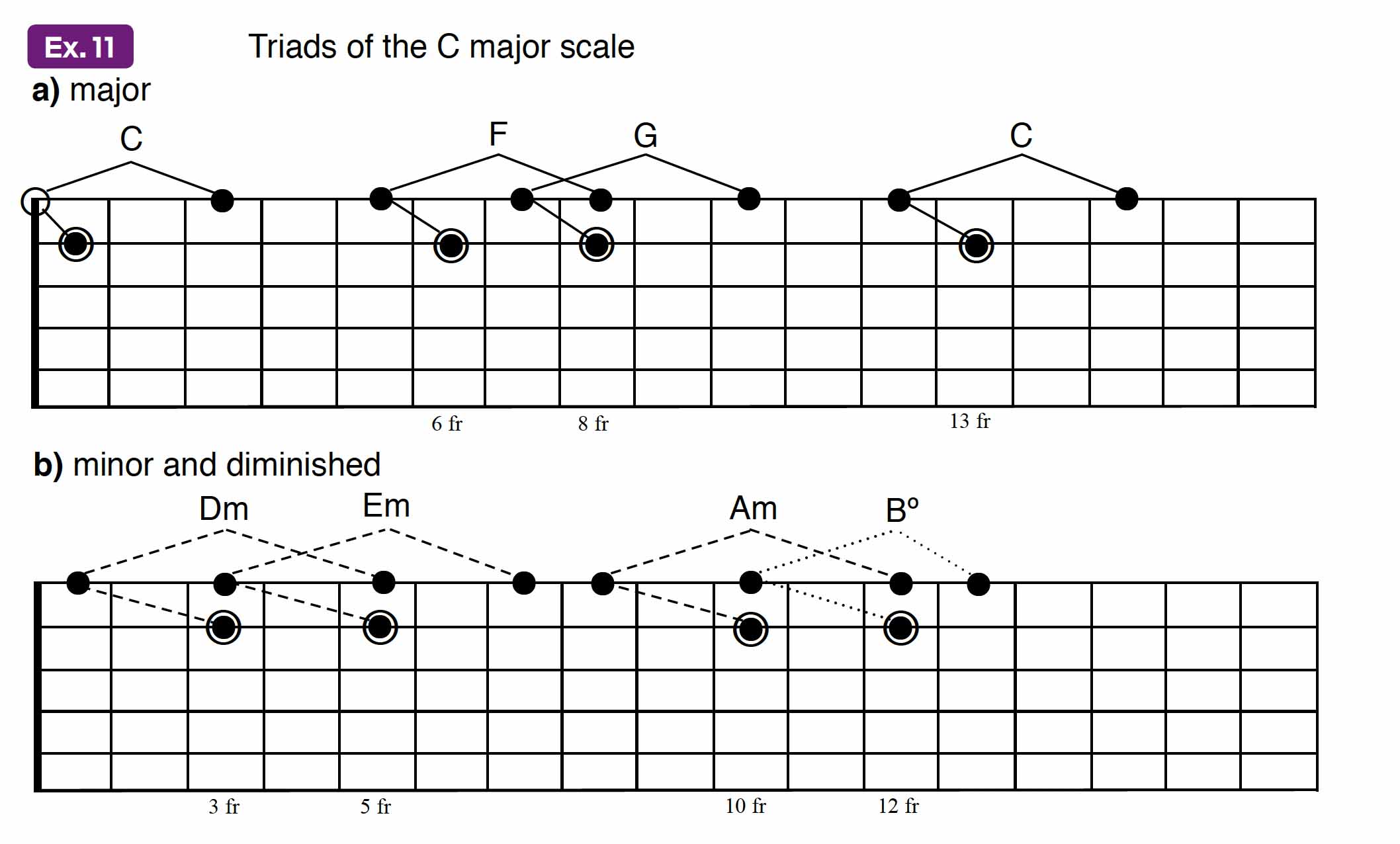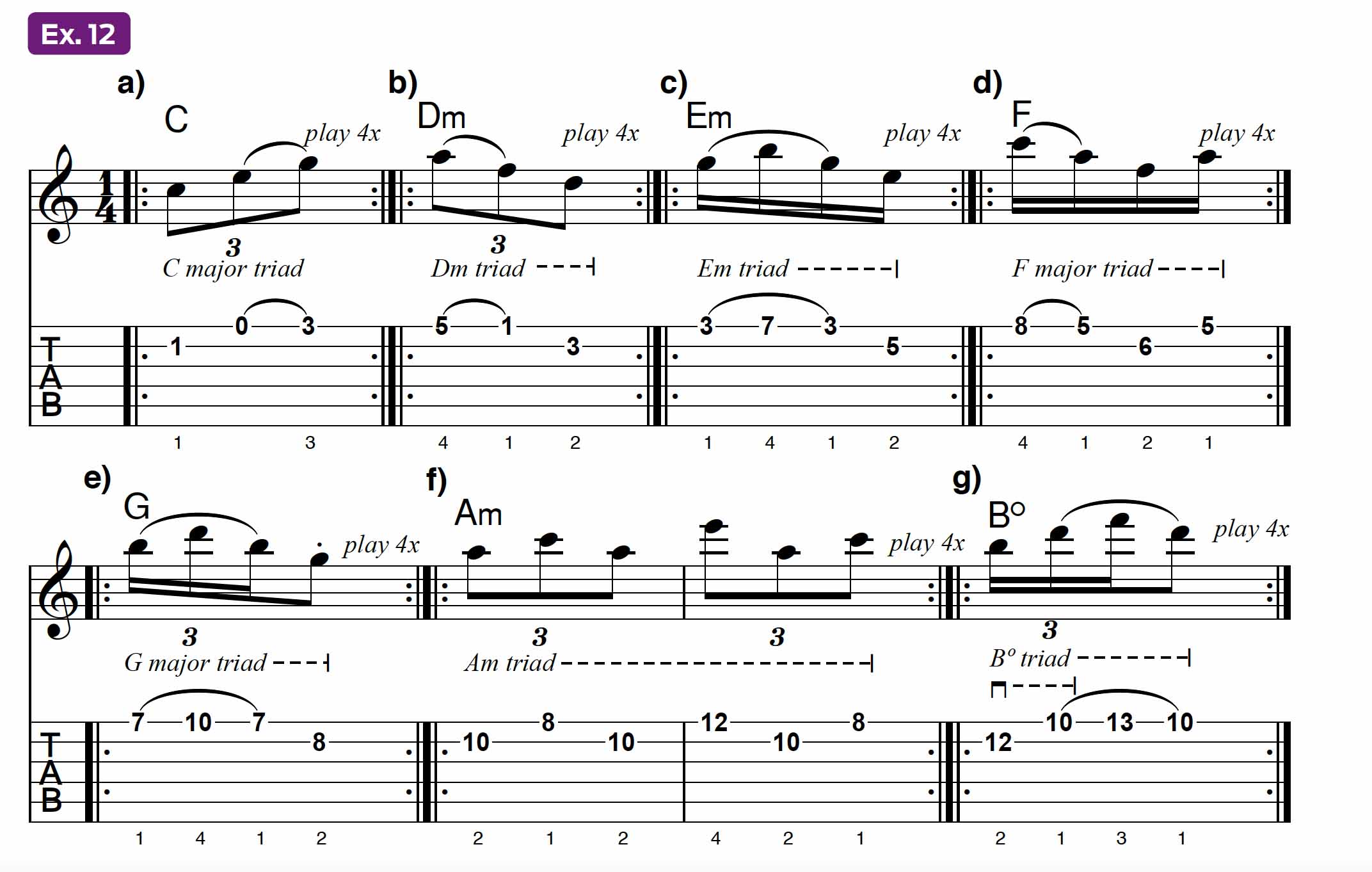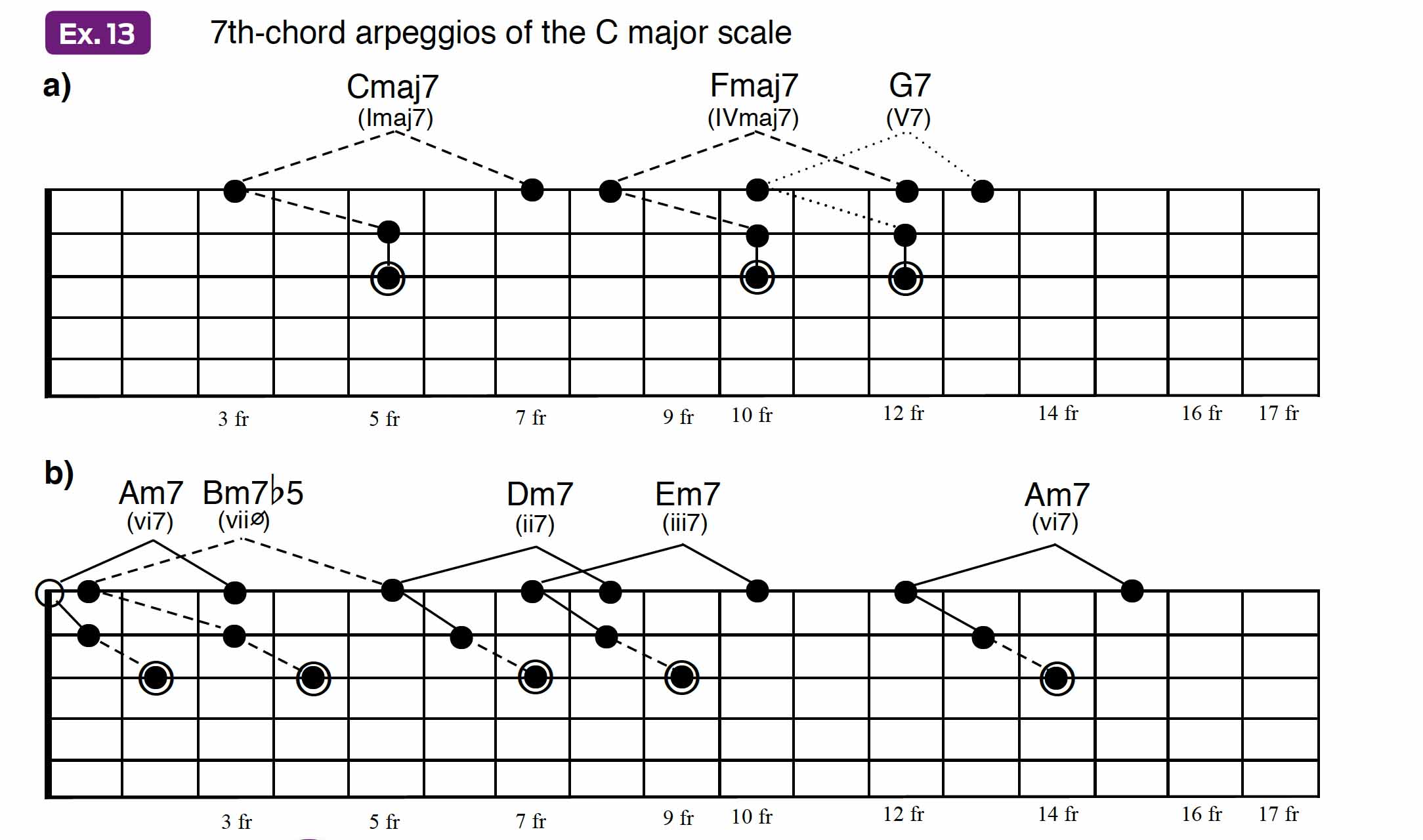
In a lead guitarist’s world, so much attention is given to scale patterns that it’s no wonder the topic of arpeggios is often put on the back burner. That’s unfortunate, as these little three- and four-note wonders — triad- and 7th-chord arpeggios, respectively — can be used to create flowing and highly appealing single-note lines that can be used to describe the underlying chord changes or to create the illusion of non-existent background harmony.
Arm yourself with a handful of arpeggio patterns and you’ll never be at a loss when faced with even the most complex chord progression. Or apply a syncopated rhythm to a simple arpeggio to generate an instant riff idea!
In this first installment of this two-part lesson, we’ll focus on the top three strings only. Part 2 will cover the bottom three strings and put everything together. For the sake of continuity and comparison, we’ll concentrate on the arpeggios of the C major scale (C, D, E, F, G, A, B). So remove your low-E, A and D strings… just kidding! Tune up those six-strings and let’s have at it.
Triad Arpeggios in Root Position
We’ll start by surveying the three fundamental types, or qualities, of triads that exist within the major scale: major (1, 3, 5), minor (1, b3, 5) and diminished (1, b3, b5). Example 1 illustrates the guitar fretboard from the nut to the 17th fret.
The three-dot groupings represent the shapes of harmonized triads of the C major scale: C (C, E, G), Dm (D, F, A), Em (E, G, B), F (F, A, C), G (G, B, D), Am (A, C, E) and Bdim (B, D, F). Solid lines are used to connect the dots that form the shapes of the major triads (C, F and G), dashed lines connect the notes of the minor triads (Dm, Em and Am), and dotted lines join the notes of the Bdim triad.
All triads are voiced root-3rd-5th, with their roots on the G string. These shapes make all of the triads playable as chords (all notes sounded together), but the object here is to play them melodically — one note at a time. You can, of course, let the notes ring together, if you like.
Example 2 is a musical exercise that takes you all the way through the triads, in ascending order, with finger slides on the G string creating a smooth transition from root to root. Experiment with the following articulation and phrasing techniques: legato (allowing the notes of each triad to ring together), staccato (dampening each note immediately after picking it), and melodic (sustaining each note for its full rhythmic value).
All the latest guitar news, interviews, lessons, reviews, deals and more, direct to your inbox!
Example 3 is almost the reverse image, descending the triads but linking them with legato finger slides on both the G string (roots) and the high-E string (5ths). Feel free to follow the established pattern all the way down the fretboard.
Example 4 is yet another linking example that segues from the 3rd of each triad with legato slides on the B string. All three of these patterns include maneuvers that will be used in one form or another in the licks that follow.
Example 5 is an extended passage that uses all the triads and legato maneuvers we just covered, except Bdim. The setting is a retro R&B ballad with jazz-fusion elements; think John Mayer meets Larry Carlton and Reggie Young. The chord progression is simple, just Cmaj7 to Dm7, but the lines use triad substitution tactics — triads that don’t necessarily align perfectly with the underlying chord tones — to cast a liquidy landscape of sweet soul licks and phrases.
Triad Inversions
We’ve covered root-position triads on the top-three string set, but there are two other voicing possibilities. They are 1st inversion, where the 3rd is the lowest note, or “in the bass,” as illustrated in Examples 6a–g, and 2nd inversion, where the 5th is in the bass, (see Examples 7a–g).
As with the root-position triads, these inversion shapes can be used as chord voicings, as well as single-note melodic arpeggio patterns. It’s actually helpful to understand their correlation to standard chord voicings. For instance, each of the 1st-inversion major and minor shapes in Examples 6a–f can easily be visualized as being the top-half of a standard barre chord (C/E aligns with a C barre chord at the 8th fret, and the Dm/F is the top half of a 10th-position Dm barre chord).
The 2nd-inversion major and minor triad shapes in Examples 7a–f resemble open-position D and Dm chord voicings. Once understood, it’s just a matter of sliding the shapes up or down the neck, so that the root “plugs into” the appropriate fret. As we know, the C major scale can be realigned to create seven modes [C Ionian (C, D, E, F, G, A, B), D Dorian (D, E, F, G, A, B, C), E Phrygian (E, F, G, A, B, C, D), F Lydian (F, G, A, B, C, D, E), G Mixolydian (G, A, B, C, D, E, F), A Aeolian (A, B, C, D, E, F, G), and B Locrian (B, C, D, E, F, G, A)].
We can use triads in this same way. Check out Example 8: This chord riff uses a variety of root-position, 1st-inversion and 2nd-inversion triads in a keyboard-like modal vamp over a G6 tonality (G, B, D, E). The triads are derived from the C major scale, giving the passage a G Mixolydian flavor. (As the notes of G Mixolydian are relative to the C major scale, so too are all of the harmonized triads, just in a different order of succession.)
Example 9 gives the D Dorian mode the triadic treatment in a progressive-rock ballad setting. These voicings are all 2nd-inversion triads found in the chord frames in Examples 7a–f. The legato-slide maneuvers are from the exercises and patterns introduced in Examples 2–4. Follow the suggested fingerings carefully, as the point is to let all the notes ring together.
We’re back to G Mixolydian in Example 10, with a rock-shuffle romp over a classic I - bVII - IV progression (G - F - C). (The pedaled tonic bass note, G, reinforces the modal vibe.) Virtually all of the triad inversions are present and accounted for in this active example.
Two-string Triads
Many rock solos feature dazzling triad displays played along the B and high E strings. Take a look at the fretboard diagram in Example 11a. This illustrates the matching shape of the three major triads in the key of C — C, F and G. The root is on the B string, followed by the 3rd and 5th on the high E. These shapes are easily fretted using your middle finger for the root note, index finger for the 3rd and pinkie for the 5th.
The neck diagram in Example 11b illustrates the shapes for the three minor triads (Dm, Em and Am) and the “oddball” diminished (Bdim). Notice that the minor triad arpeggio shapes form a wider span than the major ones, requiring the index finger to reach back a fret to grab the lowest note on the high E string.
The Bdim shape is probably best fingered using the ring finger on the B string instead of the middle finger (ring, index, pinkie) but experiment and use whichever combination of fingers works best for you. Although these two-string triad pairs can be played in succession up and down the fretboard, they are often used in cycled form (repeated several times) during a solo.
Examples 12a-g offer a variety of legato-fueled repeating patterns used over each triad shape. You can hear Jimmy Page employ the patterns in Examples 12b and 12c in many Led Zeppelin solos, such as “Stairway to Heaven,” “Rock and Roll” and “Dazed and Confused.”
Example 12d is the pattern that Mark Knopfler employed in his dizzying triad blasts during the climax of his solo in the classic Dire Straits song “Sultans of Swing.” Example 12e is built for speed, and Example 12g is a great “mini-sweep” lick. Find a pattern that speaks to you personally and try applying it to any and all of the triad shapes you’ve learned.
7th-Chord Arpeggios
If you know your basic music theory, you’re aware that to create the triads of the major scale you essentially stack diatonic 3rds on top of one another. Go one step further and stack a 3rd above the 5th of the triad and you have a 7th chord or arpeggio, as in C, E, G, B = C major 7th, or Cmaj7.
Instead of starting from scratch and learning brand new shapes for these 7th-chord arpeggios (which we will henceforth simply refer to as 7th arpeggios), we’re going to combine some of the voicings covered in this lesson.
Take a look at the neck diagram in Example 13a. The first four-note shape is a Cmaj7 arpeggio (C, E, G, B). You’ll recognize the first three notes as the root-position major triad shape we started with back in Example 1. Now look at the shape of the second, third and fourth notes (E, G and B) of the same Cmaj7 arpeggio. Look familiar? It should. This is the minor triad shape we just met in Example 11b. Specifically, an Em triad (E, G, B).
What does this mean? Well, this concept can be used as a type of speed learning. When tackling something new, try not to go back to the drawing board. Instead, try to find an element of the new material that you know well or are familiar with, and build from there. In this case, we can view a Cmaj7 arpeggio as a blending (or marriage) of two triads; C major and Em, or one overlaid on top of the other.
From this aspect look at the Cmaj7 arpeggio on the fretboard diagram again. The solid line from the root to the next note signifies a major 3rd interval (the launching pad of a major triad). From there, a dashed line connects the remaining three notes, designating a minor triad shape.
The Fmaj7 arpeggio (F, A, C, E) has the same contour, but the G7 arpeggio is slightly different. Like a G7 chord, it has the formula root - major 3rd - 5th - b7th. The use of the dotted line clarifies that this arpeggio is a G major triad with a Bdim triad overlaid on top (again, starting from the second note of the G triad).
If your head is swimming, just memorize the shapes of these 7th arpeggios for now. But by all means, try to comprehend the triad pairing concept while you’re learning them
The diagram in Example 13b displays the 7th arpeggios constructed from the minor triads and the diminished triad. (The Am7 arpeggio appears twice; once in open position, and again an octave higher at the 12th fret.) Study the minor 7ths first (Dm7, Em7 and Am7), as they all share the same voicing shape.
In a sense, they are the “upside down” versions of the major 7ths, in that they begin life as a minor triad and morph into a major triad on top. The B minor 7 flat-5 (Bm7b5: B, D, F, A) is unique, in that it wears a minor triad “hat” on top of its diminished triad foundation.
That’s a boatload of theory to digest in one fell swoop, but it is the reason this lesson is concentrating on the top three strings. If your head is swimming, just memorize the shapes of these 7th arpeggios for now. But by all means, try to comprehend the triad pairing concept while you’re learning them. The benefits and rewards will pay off in a big way for you musically and creatively, and in understanding the guitar fretboard in general.
If you’re intrigued by the triad “piggy-backing” concept, here’s a quick, helpful formula to use for reference: (Remember, the top triad begins on the second note of the bottom triad.)
- Major 7 = major triad + minor triad
- Minor 7 = minor triad + major triad
- Dominant 7= major triad + dim triad
- Minor 7 flat-5 = dim triad + minor triad
Example 14 is a lick-oriented exercise that combines several 7th arpeggios. Bar 1 aligns with a Cmaj7 chord harmony, while bar 2 is designed for the Am7 chord change. Put the example together very slowly and try to connect with the “overlapping triad” theory presented in the last few paragraphs.
Example 15 puts a capper on this lesson with an array of triads and 7th arpeggios spread out against a funk-reggae A minor groove inspired by the classic guitar duel between Don Felder and Joe Walsh in “Hotel California” by the Eagles. We’ve barely scratched the surface of the topic of triads and 7th arpeggios here, but this is a good starting point. Next month, in the conclusion of this lesson, we’ll hit the lower strings and tie all six together. Until then, happy arpeggiating!


